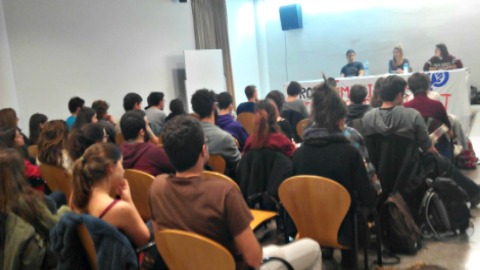3+2 and sexism: The same fight?

To put that in context, Leire Garcia explained women’s situation in the socioeconomic structure and in employment, and she stated that women are more than 50% of the population and they are most affected by casualization and part-time jobs. Furthermore, there is a wage gap between men and women of around 20%, and 80% of minimum pension beneficiaries are women.
On the other hand, Quim Ripoll mentioned 3+2 as an exploitation strategy, rather than an internationalization strategy. The reduction of the bachelor’s degree from 4 to 3 years seeks to reinforce general non-specialized subjects. This would turn the bachelor’s degree into the continuation of batxillerat and it would make studying a master almost a requirement, and masters are much more expensive than bachelors’ degree. He also mentioned that this reform would mean the dismissal of many professors.
In order to link women’s situation with the reform, Paola García highlighted that the reform is an attack to non-productive studies, which do not generate profits, and which are the studies with more female presence. In the UAB 60% of the students are female, but in masters this number significantly decreases.
Finally there was a question time and there was a comment on what kind of student movement would be necessary to fight the implementation of this measure: a massive, democratic and egalitarian movement. Particular mention was made of the importance of female empowerment in assemblies, workplaces and political organization.